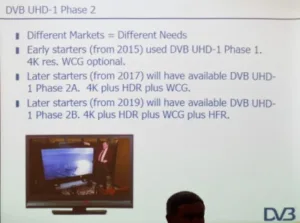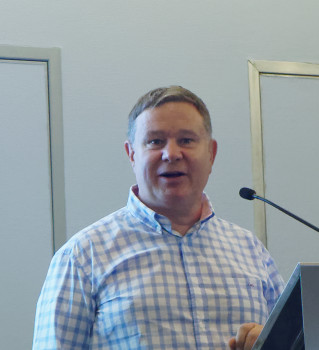 DVB held its ‘same procedure as last year’ press conference on the first day of IBC. Peter MacAvock is the newly elected chairman of the DVB to replace Phil Laven. MacAvock started by introducing himself. He has been involved with the EBU for some time and the broadcaster members of that organisation are very keen that the DVB remains a key technical ‘powerhouse’, as it has been over twenty years. DVB was developed to digitise TV and in the key markets that has been achieved, although not all of Asia has got there, yet.
DVB held its ‘same procedure as last year’ press conference on the first day of IBC. Peter MacAvock is the newly elected chairman of the DVB to replace Phil Laven. MacAvock started by introducing himself. He has been involved with the EBU for some time and the broadcaster members of that organisation are very keen that the DVB remains a key technical ‘powerhouse’, as it has been over twenty years. DVB was developed to digitise TV and in the key markets that has been achieved, although not all of Asia has got there, yet.
Why is DVB still important? One reason is that all stakeholders are present – there are 170 members representing the whole industry. The way video is consumed is changing and the DVB has to change to reflect this. There are also issues of housekeeping as the DVB evolves. Many organisations are involved in setting specifications, often in just one area, such as HDR (where there are two different technologies in HLG & PQ). The ecosystem is increasingly complex.
The DVB believes it has a strong team and a number of leaders in a range of areas involved in broadcasting.
UltraHD Developments
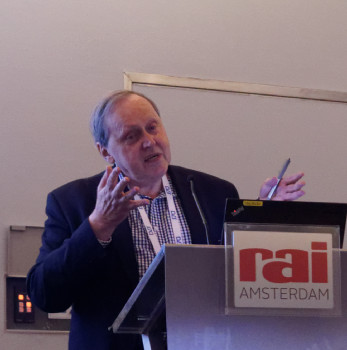 David Wood was the next speaker and he spoke about a small number of the topics that people ask about most often. For UHD, different markets have different needs at different times. Sometimes you have to wait for technology to arrive, Wood said. He presented the current roadmap of DVB plans for the various phases of UltraHD. Early adoptors are already supporting Phase 1 (from 2015) which includes UltraHD resolution, with optional wide colour gamut. UHD 1 Phase 2A adds support for HDR and WCG while Phase 2B will add HFR.
David Wood was the next speaker and he spoke about a small number of the topics that people ask about most often. For UHD, different markets have different needs at different times. Sometimes you have to wait for technology to arrive, Wood said. He presented the current roadmap of DVB plans for the various phases of UltraHD. Early adoptors are already supporting Phase 1 (from 2015) which includes UltraHD resolution, with optional wide colour gamut. UHD 1 Phase 2A adds support for HDR and WCG while Phase 2B will add HFR.
HDR has two systems, PQ and HLG, that have been specified in BT.2100 for production. DVB looks to specify and standardise how to get this to sets over the broadcast infrastructure. Some DVB members want backwards compatibility but others want new and optimised options to be available, with no compatibility constraint.
The specification has to be available from DVB before the end of 2016 and there are five proposals for HDR being considered, with important meetings being held around IBC. (Wood mentioned a ‘Qualcast’ specification, but we think he meant Qualcomm!). In response to questions at the end of the conference, Wood said that there is no certainty that the DVB can get the decision “right first time” and that may mean that DVB may put in an option to have a second version, later.
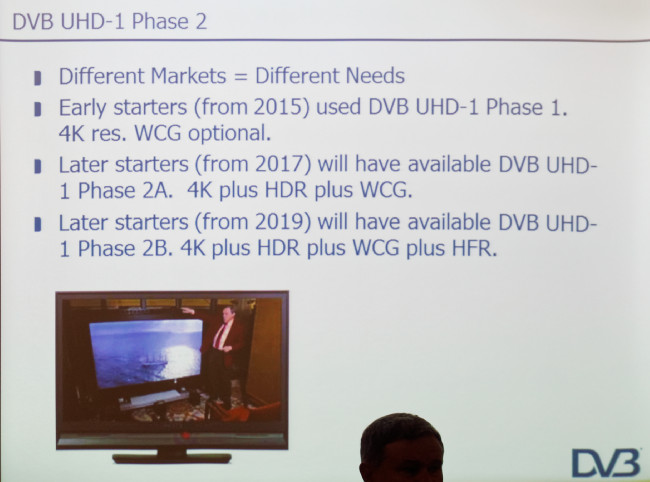
Audio
Turning to “next gen audio”, DBB has developed the “Advanced sound system” (US members don’t like the acronym, Wood said!). Audio elements can be based on loudspeaker channels or ambisonics or can be object-based – e.g. sports broadcasters will be able to support different commentaries for different teams. The compression system needs to be decided by DVB and there are two candidates, MPEG-H and AC4. Both meet the technical requirements – and it’s possible that both will be adopted and a specification is due to be available in 2016.
Virtual Reality
VR is a bit of a chaotic situation, Wood said, but MPEG, JPEG and other organisations have started looking at standardising file formats. DVB is going to decide if it should be involved. VR is more complicated than TV – there is a lot of technology but there are also issues of human factors such as motion sickness as well as questions about how to create content.
The 2018 Winter Olympics will be imaged in VR, Wood said that the content will be produced in the Nordics once received from Seoul. Will it be a fad or important, Wood asked? It’s not clear at the moment.
Work has started and there has been a study group of 30 people performed by BCom in France. BT/UKTV/ the BBC and others are also testing and experimenting and it already seems as though short form content seems best. Qualcomm chairs an MPEG group on file formats.
On the Booth
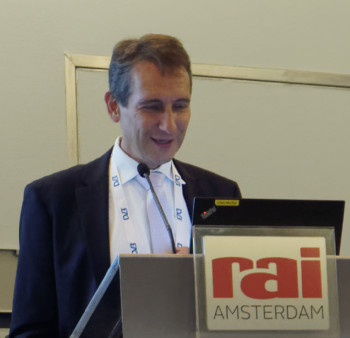 Peter Siebert form the DVB project office then described what would be on the booth. There are new devices to consume video – how do you get broadcast signals to them? The new devices are mainly used indoors, although sometimes outdoor.
Peter Siebert form the DVB project office then described what would be on the booth. There are new devices to consume video – how do you get broadcast signals to them? The new devices are mainly used indoors, although sometimes outdoor.
Europe already has the SAT>IP technology and this is a Cenelec standard, so DVB is showing that on the booth. DVB-T2 is good for consumption out of the home, Siebert said. There are big markets with DVB-T2 using small antennas on the go and Sony has a tuner for DVB-T2. The demo on the booth showed a Panasonic TV (with Sat>IP) getting a T2 broadcast signal and sending that to a tablet using DVB>IP.
The DVB S2X extensions to DVB-2S are being used, but mainly for professional apps and Broadcom now has a chip to support this. Satixfy has a chip that is intended to offer cost efficient broadband via satellite, but this needs cheap silicon. STMicroelectroncs has a receiver chip with white band and 8 demodulators.
Questions
In questions, DVB said that DVB-C2 was developed, but not used because cable operators can keep splitting their networks to be smaller and smaller to provide better and better broadband, without changing their STBs. If they move to C2, new set top boxes are needed and this investment can “destroy the balance sheet”.
In response to a question about the “Future of broadcast TV” initiative. DVB said that it hasn’t done much recently. Platforms and content prodiuction has been harmonised globally, but broadcast remains, relatively fragmented. ARIB (the Association of Radio Industries and Businesses) in Japan and the ATSC in the US have been talking about next gen of UHD TV – it would be good if it was aligned with Europe, DVB thinks.
In response to a question about DVB-T2 implementation, it was pointed out that it can use 64QAM or 256QAM. Germany uses 64 while the UK uses 256. 64 is more robust for mobile and may be used for applications such as automotive reception.
DVB will run a DVB Aisa event in Bangkok on 29th November. The next DVB world will be in Vienna in March.

